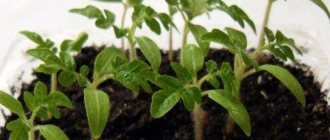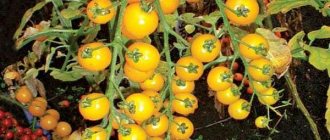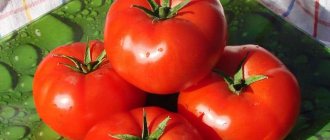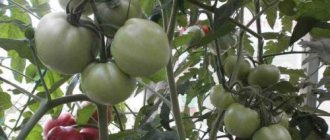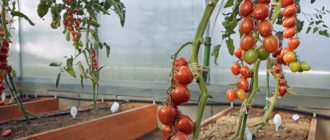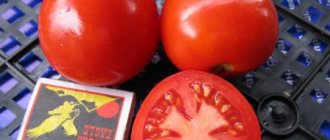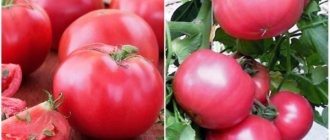A tomato with such a gentle name as Gloria corresponds to tomatoes with strong, hardy bushes and amazingly tasty fruits. The variety is one of the oldest. Created by special order at the Moscow Research Institute by Soviet breeders in 1970.
| Height | Landing location | Ripening time | Fruit color | Fruit size | Origin | Fruit shape |
| Medium height | Greenhouse, Open ground | Mid-season | Reds | Average | Variety | Plum-shaped or oval |
Description of the variety
The variety was bred in 1970 by the Moldavian Research Institute of Irrigated Agriculture and Vegetable Growing. In 1975, it was zoned in the North Caucasus, Tajikistan, central black earth regions, Ukraine and the Volga region. Having proven itself well in these territories, the variety began to be cultivated in other regions of the former USSR.
Tomato Gloria gives a high yield, up to 4 kg per bush. It does not require much attention and is suitable for both open ground and greenhouses. In open ground it grows up to a meter in height, in a greenhouse - up to 1.5 m.
The fruits are shaped like a plum, weighing from 100 to 200 g. They are sweet, with a slight sourness. They have a dense, elastic shape and at the same time quite fleshy.
Fruit characteristics:
- color – red;
- shape – round-oval (see photo);
- pulp – pleasant consistency;
- consumer qualities – high;
- transportability – good;
- keeping quality - about 60 days.
These tomatoes are ideal for fresh consumption and in salads, and are good for pickling and canning.
Advantages of the variety
Gloria cluster tomatoes are intended for growing in open ground and greenhouses. During the growing season, the semi-determinate bush reaches a height of 1.5 m. The plant requires tying to a support and removing excess shoots.
Tomatoes of the Gloria variety belong to mid-season vegetable crops. It takes 115-120 days from the moment the seeds sprout to fruiting. If the rules of agricultural technology are observed, 5-8 kg of fruits are removed from 1 m². The first flower cluster is laid at the level of 7-8 leaves.
The growth of the bush is limited after the formation of 10-12 flower clusters, which are laid at intervals of 2-3 leaves.
The largest harvest is harvested from the bushes if the plant is maintained with 3-4 stems. At the stage of ripeness, the fruits acquire a red color, their weight reaches 150-200 g. The tomatoes are slightly elongated in shape and resemble a plum in appearance.
The main advantage of the variety is the uniform ripening of fruits in the cluster, which has a positive effect on the crop yield. Tomatoes tolerate transportation well over distances and retain their taste for 60 days after harvest.
The description of the variety is associated with the excellent taste of tomatoes. In cooking, tomatoes are used fresh for making juices and sauces. When canned, tomatoes retain their shape. This characteristic captivates many housewives.
How to grow seedlings
The time for sowing Gloria tomato seedlings depends on the growing location. For open ground, sow seeds no earlier than the end of February, for a greenhouse - at the beginning of March.
Important ! When choosing tomato seeds, be sure to pay attention to their release date. The best germination will be for seeds produced no more than 2 years ago.
Seed preparation
To begin with, the seeds are soaked in a salt solution and empty ones that are not suitable for sowing are identified. For disinfection, soak in 1% potassium permanganate. The product “Kornevin” is used to saturate seeds with nutrients.
Then you need to germinate them. To do this, wrap it in gauze or cotton cloth moistened with water, pack it in a plastic bag and place it on the battery. After 3-5 days they hatch. Start sowing. For sowing, you need to purchase nutritious soil for vegetables and drainage (you can use regular eggshells).
Soil for sowing future tomatoes can be found at any gardening store. The store-bought mixture is diluted with garden soil, but there is a danger that the soil brought from the street will be contaminated with bacteria or a virus.
To prevent this from happening, 3-5 days before sowing we bring soil from the beds so that it has time to warm up. To disinfect, pour it well with a solution of potassium permanganate (1-2%) and let it stand for another 1-2 days. After this, mix the purchased soil with garden soil in equal proportions and fill the containers for seedlings with them. There are two types of containers.
Individual pots
Take plastic cups and cut special holes in the bottom for drainage. Then pour the prepared drainage onto the bottom. This could be expanded clay, small pebbles or eggshells. Fill in the soil and water well with warm water.
Make small depressions (1-2 cm) in the ground and plant 2-3 tomato seeds in them to ensure germination. Spray carefully with a spray bottle. We cover the finished containers with film and place them in a warm place.
Important ! After sowing the seeds and until germination, water the soil only with a spray bottle. Running water will cause the seeds to sink deep into the ground and not be able to sprout.
General capacities
Containers for seeds are chosen at a shallow depth, sufficient for germination. Fill with prepared soil and water well. Next, mark the approximate distance for future rows, there will be 3-4 cm between them. Place tomato seeds in the resulting rows every 2 cm. Using a wooden stick (you can use a sushi stick), push the seeds to a depth of 1-2 cm. Then sprinkle with earth. There is no need to water the crops anymore.
The finished containers are covered with cling film or covered with glass and placed in a warm room, closer to the radiator, until the first shoots appear.
After 3-7 days it is possible to see the first shoots. It is necessary to move the shoots to another, cooler room, or adjust the temperature in the same room to 16-18°C.
For a good result, you need to remember that seedlings need to be in the light for at least 12 hours a day. You can purchase a lamp for additional illumination in a special store. Due to lack of light, the sprouts begin to stretch, become thin and brittle.
Hardening of seedlings
When transplanting, especially into open ground, plants experience severe stress. To soften it, the hardening procedure begins 1.5-2 weeks before planting. Watering is stopped within a week. The seedlings are taken out of the room to a cool place. An enclosed balcony is good for this. To start hardening, choose a warm sunny day.
2-3 hours after sunrise, when the temperature in the yard rises above 10°C, we take the plants out for an hour. Increase this time by another hour every day. 3-4 days before planting, the seedlings can be left to spend the night outside (in good weather without minus).
If there is still a threat of frost at night, return the plants indoors and reschedule their planting accordingly. Planting seedlings that have been left outdoors for less than three days is dangerous - they can get sick.
Important ! To prepare the soil before planting, spray it with Fundazol.
Features of caring for seedlings
In order for the yield to be high, it is necessary to organize proper care of the bushes.
Picking seedlings
The process of picking seedlings is important if you planted the seeds in a common container, and as they grew, the seedlings became crowded. They will interfere with each other, since during the period of active growth, plants require a lot of useful substances and oxygen. This is especially important for a growing root system.
Important ! If the above-ground part does not receive oxygen, then the roots, especially on dense soils, begin to experience oxygen starvation.
Top dressing
The first feeding is done no earlier than 1.5-2 weeks after picking (if the seedlings were planted in a common container). After two weeks, you can do the second feeding. Both chemical compounds (can be purchased at the store) and organic fertilizers mixed at home are well suited for fertilizing.
As a fertilizer, you can take a mixture of 20 g of superphosphate, 10 g of urea and 15 g of potassium chloride, mix in 10 liters of water. An infusion of ash (1 tbsp per 2 liters of water, let sit for 24 hours) and eggshells are also suitable (a three-liter jar is filled 2/3 with egg shells, then with water and infused for 3 days).
Timely fertilizing is the key to a bountiful harvest.
Important ! The last time to fertilize the seedlings is no later than a week before planting in open ground.
Features of cultivation
Sowing the seeds of this variety of tomatoes for seedlings is carried out 60-65 days before the intended planting in the ground. Scheme for planting seedlings in the ground : 40 x 50 cm, planting density: up to 4 plants per 1 sq. m.
If you grew Gloria tomatoes, please write whether you liked them or not. What was the yield and taste of the fruit under your conditions? Has this variety become your favorite? If possible, attach a photo of these tomatoes to your comment. Thank you!
Your reviews of the Gloria tomato and additions to the description will help many tomato lovers evaluate this variety more objectively and decide whether it is worth growing or not.
How to grow tomatoes
For tomatoes, choose a sunny place, well protected from wind and frequent drafts. Damp, low areas in which groundwater is located close to the surface are not suitable. The root system rarely takes root in such places; the tomato does not produce a good harvest.
It is not recommended to grow the crop in the same place every year. If the area of the plot does not allow for crop rotation or you are planting in a greenhouse, disinfection or changing the top layer of soil (4-5 cm) is necessary.
If the previous bushes were sick, the soil layer is cut off by 10 cm. After this, the soil is sprayed with a hot solution of copper sulfate. In place of the removed soil, a fertile mixture of turf or leaf soil, sand, and rotted humus is poured.
Landing
To successfully grow tomatoes, gardeners advise allocating at least 0.3 square meters per bush. m. Before planting, the soil must be shed with hot water and potassium permanganate.
Solution recipe:
- boric acid 1/3 teaspoon;
- potassium permanganate on the tip of a toothpick;
- 3-5 drops of iodine;
- 3 liters of water.
Application:
- Mix boric acid in warm water (40-45 degrees) until the crystals are completely dissolved.
- Dissolve potassium permanganate in a separate container in 3 liters of water until a pale pink color is obtained.
- Add 3-5 drops of iodine and dissolved boric acid.
Carefully remove the seedling. Tear off all the leaves, leaving the top three. Lower the bush with a lump of earth into the hole, add compost, compact it, and cover it with dry soil. Do not cover the stem with soil.
Place a 10 cm layer of mulch on top of sawdust, straw or wilted grass. Only after 15 days are the plants hilled to a stem height of up to 12 cm.
Attention ! At the time of planting, the soil should be heated 20 cm deep to +10°C...+12°C. In May you can plant it in a permanent place. If it is cloudy on the planting day, then you can plant in the morning, if it is sunny, then in the evening.
Bush care
Seedlings need to be regularly watered, weeded and hilled. When the ovaries appear, the tomatoes are watered once a week. They do not tolerate excess moisture, which leads to the development of fungal diseases. Water under the root with warm water.
After each watering and after rain, it is recommended to loosen the soil under the bushes. In hot weather, this reduces the evaporation of moisture, and in cold weather it reduces the risk of infection with fungal diseases and ensures optimal gas exchange between the earth and air.
A peg must be placed next to each bush on the north side. Tethered bushes are easier to process and water.
Important ! For gartering, prepared wooden pegs are used. They are installed at a distance of 10 cm from the stem to a depth of 30 cm. It rises above the ground to 70-80 cm. The bush is tied to this peg as it grows.
To obtain more fruits and their rapid ripening, the bushes need shaping. Gardeners advise leaving one main stem and removing the rest.
The pinching procedure must be performed regularly. Those sprouts that form from the base of existing brushes must be removed. You also need to pinch off the leaves growing below the first branches.
To fertilize tomatoes, mineral compounds mixed with humus in a ratio of 1:3 and simple fertilizers are used:
- urea;
- ammonium nitrate;
- ammonium sulfate;
- nitrogen.
It is recommended to feed tomatoes three times during the summer.
The harvest of tomatoes grown in open ground begins in mid-July and continues until the end of October. Fruits that will be collected after frost are not suitable for storage and consumption.
Tomato Gloria - description and characteristics of the variety
Among all vegetable crops, gardeners especially value various varieties of tomatoes. Tomatoes form part of a healthy and healthy diet for people. All varieties of vegetables are good for fresh consumption and are used for preparing first and second courses. Various preparations are made from tomatoes, both from fruits alone and in combination with other vegetables. Often on a person’s table there is tomato juice, ketchup or various sauces.
Tomatoes of the Gloria variety are distinguished by their relative unpretentiousness to climatic conditions and care. Mid-ripening fruits can be obtained when grown in greenhouse conditions and in open ground.
Description of the variety
The fruits have an elongated round oval shape. The skin is dense, has a rich red color, there are several seed chambers inside, the pulp is moderately juicy. The weight of one tomato varies between 120-200 grams. The taste is sweet with slightly sourness. The fruits have a high shelf life and are perfectly preserved for two months. Sowing of seeds begins 50-60 days before the start of fruiting.
Features of cultivation
It is recommended to sow seeds in late February - early March. First, purchased seeds are soaked in water, but only those that sink to the bottom should be used for sowing. For faster germination, you can treat them with a special accelerator. To carry out disinfection, the seeds can be kept in a manganese solution.
- For sowing you need to prepare boxes and soil. Fertilizers should be added to the soil taken from the garden. You can use humus and peat. The earth must first be calcined for 3-4 hours in the oven or on the stove. This will help get rid of harmful viral infections and fungi. After preparing the soil, it must be poured into prepared boxes and the seeds must be sown. The top needs to be covered with film material, or you can simply cover it with glass. The boxes are placed in a warm place with access to sunlight.
- After the emerging seedlings have 2-4 leaves, the seedlings need to be pricked. For this, separate containers are prepared and the seedlings are planted.
- Planting in a permanent place must be done in prepared holes in the ground. You need to add fertilizer there and water well. Near the holes you need to install supports to which the bushes will be tied as they grow. Four seedlings should be planted per square meter. The distance between the holes should not exceed 50 cm. The same distance can be left between the rows.
- Before planting seedlings in the ground, it is recommended to harden them off. To do this, the plants are taken outside for a short time within a week or two. This is required so that the tomatoes get used to changes in temperature and quickly adapt to outdoor conditions.
- To ensure that the fruits are large and healthy, you need to regularly pinch off excess stems and leaves. For normal development and growth, additional care is required throughout the summer season.
The nuances of growing in open ground and in a greenhouse
The Gloria tomato variety has its own nuances when choosing a planting site. Take them into account, and you will be able to reap a great harvest. It is necessary to transplant seedlings into open ground in cloudy weather, in the morning or afternoon, at a temperature of +18°...+21°. The Gloria variety has a negative attitude towards sudden temperature changes.
It is better to avoid transplanting in the open, scorching sun. This can have a detrimental effect on young plants. The land must be prepared, fed and watered.
At first, you need to cover the tomatoes with soft film overnight. During the day, the film is removed to allow air circulation.
In a greenhouse, it is important to monitor the humidity level. Most often, late blight appears in greenhouses due to high humidity and sudden temperature changes. The water temperature for irrigation should be at least 20 degrees.
Agricultural technology
To grow plants in greenhouse conditions, seeds of the Gloria variety are recommended to be planted at the end of February. For open ground, the best time for planting will be the first days of March.
Before transplanting to a permanent place of growth, the seedlings must first be hardened off for 2 weeks. In this case, even at + 2 degrees, it will not suffer from hypothermia, which will prevent the inflorescences from falling off.
Planting of seedlings is carried out according to the following scheme: 40 x 50 cm, taking into account up to 4 bushes per square meter.
For good development of the variety and high yield, the vegetable crop after transplantation needs the following care:
- formation of a bush by pinching and pinching;
- regular watering;
- weeding;
- loosening;
- fertilizing with mineral fertilizers;
- garter of bush and fruit clusters;
- late blight treatment.
When growing the Gloria variety, do not forget about pests. Timely prevention of insects will also prevent the occurrence of various diseases that can negatively affect the yield of vegetable crops.
Harvesting and application
There are no difficulties during harvesting. The main feature of Gloria fruits is that they are large, but not very elastic. It is because of this that you need to carefully stack the fruits, each separately, so as not to crush them. Tomatoes can be consumed in various forms.
Tomato is consumed fresh and homemade sauces and juices are made from it. Salting, marinade, lecho and adjika turn out wonderful.
Advantages and disadvantages of the variety
Like all varieties, Gloria has its pros and cons. Let's list and analyze the main ones.
Pros:
- A fairly productive variety, you can harvest 2-4 kg from one bush;
- simple and unpretentious to grow;
- easily tolerates drought and also does not suffer from excess water;
- resistant to late blight.
There are few disadvantages:
- need for garter;
- tendency to fruit cracking.
Tomato Gloria - description and characteristics of the variety
Tomatoes of the Gloria variety are distinguished by their relative unpretentiousness to climatic conditions and care. Mid-season pomona gifts can be obtained when grown in greenhouse conditions and in open ground.
Variety status
The bushes of the plants are of short stature, reaching a height of approximately 1 meter, the ovaries are formed in the form of brushes. During growth and development, one bush forms from 10 to 12 brushes. Inflorescences form through every two leaves. To obtain a richer harvest and larger tomatoes, it is advisable to pinch the top of the bush. This will help stop the growth of the shoot and release nutrients to the development of the fruit. The bushes need to be tied to wooden or metal supports, and excess branches and leaves must be removed.
Pomona gifts have an elongated round oval shape. The skin is dense, has a saturated red color, there are several seed chambers inside, the pulp is moderately juicy. The weight of one tomato varies between 120-200 grams. The sensation is sweet with slightly sourness. The fruits have a high shelf life and delightfully remain for two months. Sowing of seeds begins 50-60 days before the start of fruiting.
Features of cultivation
It is recommended to sow seeds at the end of February - at the beginning of Marfa. First, purchased seeds are soaked in water, but only the seeds that sink to the bottom should be used for sowing. For faster germination, you can treat them with a special accelerator. To carry out disinfection, the seeds can be kept in a manganese solution.
- For sowing, you need to prepare boxes and soil. Fertilizers should be added to the soil taken from the garden. You can use humus and peat. The earth should first be calcined for 3-4 hours in the oven or on top of the stove. This will help get rid of harmful viral infections and fungi. Then prepare the soil, pour it into prepared boxes and stir up the seeds. The top needs to be covered with film material, but you can simply cover it with glass. The boxes are placed in a warm (place) position with access to sunlight.
- After the emerging seedlings have 2-4 leaves, the seedlings need to be plucked. For this, separate containers are prepared and the seedlings are planted.
- Planting in a permanent place must be done in prepared holes in the ground. There you need to add fertilizer and water well. Near the holes you need to assign supports to which the bushes will be tied as they grow. For one square meter, four seedlings should be planted. The distance between the holes should not exceed 50 cm. This distance can be left between the rows.
- Before planting seedlings in the ground, it is recommended to harden them off. To do this, the plants are taken outside for a short period of a week or two. This is required so that the eggs get used to changes in temperature and quickly adapt to outdoor conditions.
- To ensure that the fruits are large and healthy, you need to systematically pinch off excess stems and leaves. For normal development and growth, additional care is required throughout the summer season.
Care for (mushroom) tomatoes of the Gloria variety
The Gloria variety has fairly stable immunity to various diseases. Bushes are not very susceptible to diseases such as anthracnose and fusarium. In addition, tomatoes have a fairly dense skin and are not prone to cracking. Although, to achieve excellent results, you need to carry out the following activities:
- Systematically loosen the soil around the plant shoots and remove weeds. Mulching the soil and adding organic minerals will benefit growth and development. Plants need to be fed 2-3 times after summer.
- It is necessary to water the tomato bushes systematically, preventing the soil from drying out. The butts do not like drought, and can wither or even disappear without a penny from lack of water.
- Tying and pinching is a component of obtaining a rich harvest and large, fleshy fruits.
The Gloria brand of tomatoes is excellent for long-distance transportation, which is why trading companies often use it for transportation and further marketing. A long storage period will allow you to enjoy fresh, juicy fruits for a long time.
Video: Gloria Tomato Class
Farmer reviews
Gardeners who have already tried the variety in their gardens note the bright taste of the tomatoes and the juiciness of the fruits.
Tamara, Moscow : “Very tasty, especially in the greenhouse. They were not the largest in size in my garden, but they were the sweetest and meatiest.”
Elena, Saratov: “Very tasty and meaty tomatoes. I did not experience any difficulties in landing. And the harvest is so large that you can make all kinds of twists, pickles, tomato paste and juice.”
Galina, Berdsk: “A successful variety. Easy to care for, reliable, productive and tasty.”
Proven for many years - Gloria tomato: detailed description of the variety and its characteristics
A tomato with such a gentle name as Gloria corresponds to tomatoes with strong, hardy bushes and amazingly tasty fruits. The variety is one of the oldest. Created by special order at the Moscow Research Institute by Soviet breeders in 1970.
| Height | Landing location | Ripening time | Fruit color | Fruit size | Origin | Fruit shape |
| Medium height | Greenhouse, Open ground | Mid-season | Reds | Average | Variety | Plum-shaped or oval |
Description and characteristics of the variety
Tomato Gloria is a semi-determinate, medium-sized, non-standard variety. The shoots grow up to 1 m. 10-12 fruiting clusters are formed on the bushes. Bookmarking occurs every 2 leaves. The first raceme with ovaries is formed after 7-8 true leaves.
Tomatoes have an elongated round-oval shape. The color is bright red, with a beautiful gloss. When broken, the fruits are fleshy and moderately juicy. The pulp is tender and has a pleasant consistency.
The taste harmoniously combines notes of sweetness, sourness and spice.
Advantages and disadvantages
- good productivity;
- healthy composition;
- commercial qualities;
- ease of cultivation;
- drought and heat tolerance;
- resistance to many pathogens.
Minuses:
- the need for garter and fertilizing.
Productivity
From 1 m2 they harvest 10-12 kg, the yield from 1 bush is 4-4.5 kg.
Features of cultivation and storage
The timing of sowing seeds is the end of February, the first half of March. The seeds are soaked in a salt solution and whole and without defects, which have sunk to the bottom, are selected. For disinfection, soak in 1% potassium permanganate. To improve germination, use “Kornevin” or “Zircon”
Features of caring for seedlings:
- dive;
- additional lighting;
- feeding;
- hardening.
Tomatoes are easily transported without damage or deformation.
Planting and care
Seedlings are planted in stationary beds at the age of 50-55 days.
To achieve high yields:
- form bushes with 2-3 shoots;
- stepchildren are pruned once every 10-12 days, side shoots that have reached 5 cm are removed, stumps are left 2 cm long;
- watered 2 times a week, the norm is 6 liters, water is poured under the root;
- mulch with a layer of straw or hay 10 cm thick.
Fertilizing is carried out after transplanting into the ground after 2 weeks. The following fertilizer applications are indicated during flowering, during the setting and ripening of tomatoes. Use chicken manure diluted 1:10, mullein, bio-infusions, and yeast solution. The most important mineral fertilizers for tomatoes are:

